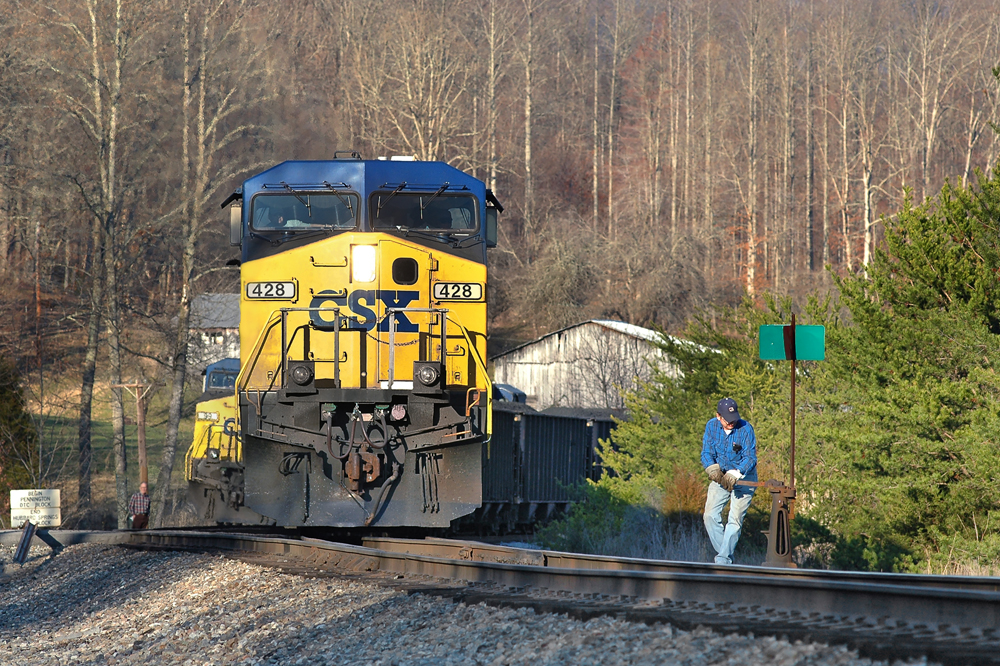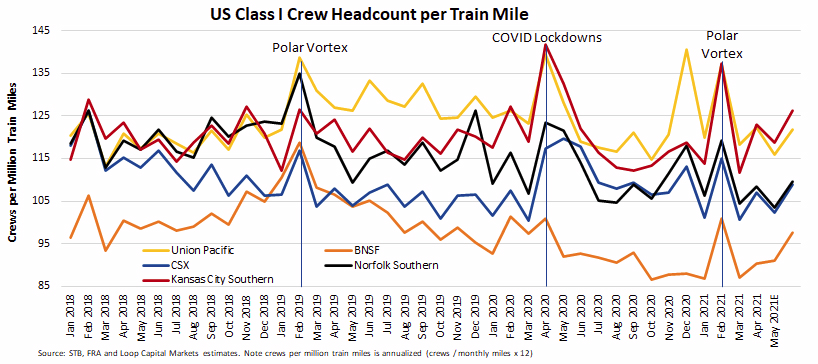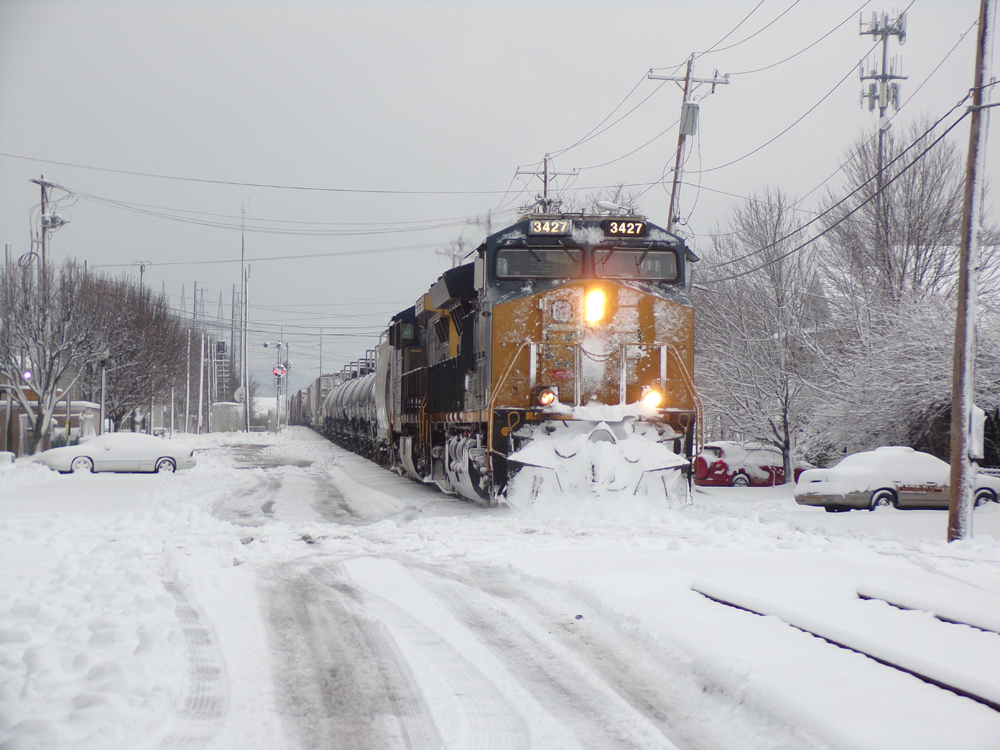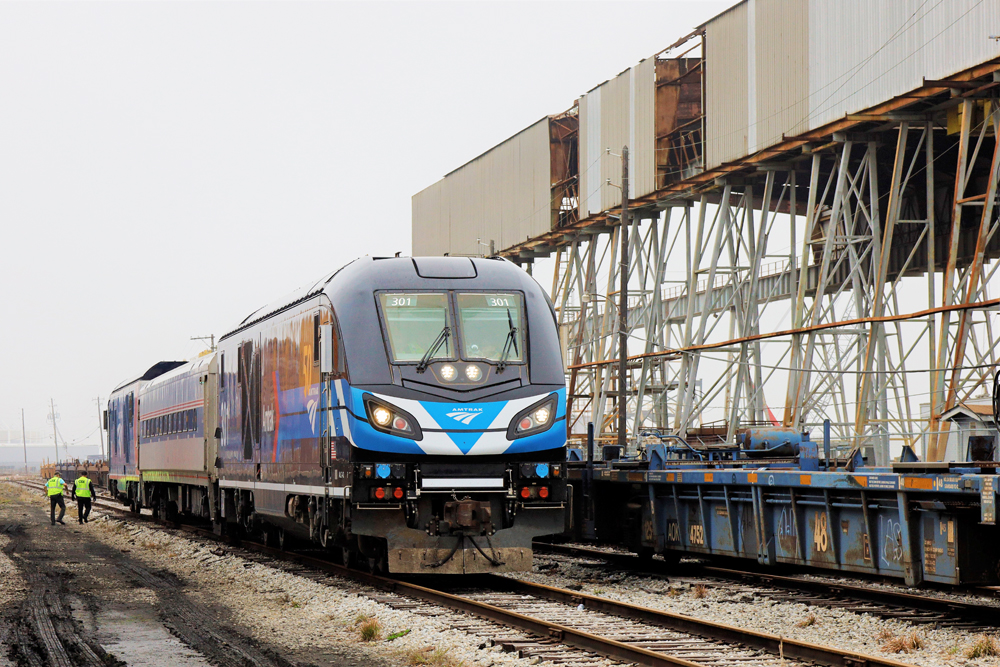
JACKSONVILLE, Fla. – Last month, CSX Transportation CEO Jim Foote lamented the shortage of people who want to work in train and engine service.
“No way did I or anybody else in the last six months realize how difficult it was going to be to try and get people to come to work these days. It is an enormous challenge for us to go out and to find people that want to be conductors on the railroad, just like it’s hard to find people who want to be baristas or anything else,” Foote said on CSX’s July 21 earnings call. “It’s very, very difficult.”

Foote’s railroad is not delivering carload freight on time, largely due to CSX’s inability to hire enough conductors. Like other railroads, CSX furloughed train crews last year at the onset of the pandemic. Now volume is back, but fewer furloughed employees than expected wanted to return.
This has put CSX in a pickle, because it’s tough to find workers in an extremely tight job market. CSX is seeking conductors at 48 locations across its system, according to job postings on its website.
Not all railroads are in the same fix.
Norfolk Southern is hiring conductors in 30 locations, mostly to keep up with anticipated attrition in the ranks. “We are facing some spot labor shortages, but they’re just that,” NS CEO Jim Squires said on an earnings call last week. NS has increased its training wage and also has offered some signing and retention bonuses to new employees.
In the West, BNSF Railway is not hiring conductors, while UP is seeking conductors in just five locations.
Canadian National is hiring conductors at 30 locations, while Canadian Pacific is hiring at 19 terminals. Both railways are offering signing bonuses in a few locations. Kansas City Southern, the smallest Class I, is hiring conductors at seven U.S. locations.
Foote outlined the railroad’s hiring plans in a June service outlook letter to the Surface Transportation Board, but that letter offered no hint that CSX was having trouble hiring.
“In our June 17th response to the Surface Transportation Board, CSX discussed our hiring plans to increase staffing in order to meet growing demand. Our goals have not changed, yet our efforts to achieve those plans have become more aggressive, including offering our employees a $3,000 referral bonus for each conductor that completes our training and becomes a CSX employee,” CSX spokeswoman Cindy Schild says. “… Our hiring plan is reviewed on a weekly basis, and modified to adjust for our business needs as necessary.”
CSX also reached a new agreement with the SMART-TD union to boost availability of current conductors, who receive a weekly bonus in stock or cash for perfect attendance. CSX would not confirm reports that the cash figure is $500.
CSX Falls Short of Hiring Goals
Foote says CSX had hoped to have 500 new conductors on the property by July. Instead, it has been able to hire only about 200 people.
But those figures only tell part of the story. CSX had 1,129 fewer train and engine employees in the second quarter of 2021 compared to second-quarter 2019 figures, according to data reported to the STB. Overall traffic levels were similar, with second-quarter 2019 volume 0.63% higher than this year. CSX’s traffic mix has changed considerably, however, with coal down 19% and crude oil volume also down significantly, which reduces demand for crews somewhat.
Rick Paterson, a railroader turned analyst at Loop Capital Markets, says CSX performance metrics and train crew employment data are a bit puzzling.
In recent weeks, he notes CSX has been reporting an average of five or fewer train delays per day due to crew shortages, well below the 10 trains held per day that represents problematic levels for the Eastern railroads.
CSX also is within a normal range for crew levels when measured by crews per million train-miles. “Through June it was running with about 109 crews per million train-miles (train-miles annualized). While CSX is the second lowest/leanest in the industry, this number is not low for CSX. In fact, CSX has averaged 108 since the start of 2019,” Paterson says.

The impact of CSX’s crew shortages may be showing up more in local service. Class I railroads are not required to report local service metrics to federal regulators.
“If local crew shortages are indeed the problem I’d expect to see trip plan compliance weak relative to overall service metrics, and a large gap between intermodal and carload trip plan compliance, given the former doesn’t have local service,” Paterson says. “Arguably, both have occurred. Trip plan compliance in Q2 for CSX was 69% for carload (vs. 67% in Q1) and 89% for intermodal (vs. 85% in Q1). Carload trip plan compliance was in the mid-80s when CSX was running well in 2019, with a much narrower spread between carload and intermodal trip plan compliance.”
Foote says it may take until the end of the year for merchandise service to return to pre-pandemic on-time performance levels, unless there’s a dramatic turnaround in the hiring situation.
“It takes six to nine months to find, hire, train, and place a conductor,” Paterson says. “So weak hiring in Q2, for example, is going to show up in Q4, when crew attrition potentially exceeds new conductor placements in the field. So CSX may be running OK today … but management is worried about tomorrow.”
A Tougher Road for CSX
CSX is more affected by the national job crunch than other railroads for several reasons, says Nick Little, managing director of the Railway Management Program at the Eli Broad College of Business at Michigan State University.
Some crews furloughed at the onset of the pandemic were lured into other jobs, such as construction, that pay well and have a better work-life balance than the railroad, Little says. He sees the same phenomenon in the trucking industry, where there’s a persistent shortage of drivers.
Anecdotal evidence indicates other CSX conductors and engineers did not want to return to or stay with the railroad due to job changes related to the implementation of Precision Scheduled Railroading, “Feeling uninspired can make people leave,” Little says. “They want to feel valued. I’m not sure CSX does that as well as some of the other railroads do.”
Little spoke with one CSX engineer who retired as soon as he could. “He didn’t like the management relationship and he felt that he’d had enough,” Little says. “They were being asked to do more for less all the time.”
Also, many of CSX’s terminals are located in areas that traditionally have been harder to find workers. “I think CSX would always have a tougher job — marginally tougher than NS but certainly a lot tougher than UP or BNSF — to retain its people and then to get new employees that will stay with them,” Little says.
Long-Term Solutions
Railroads have long had trouble matching crew levels to unexpected — or larger than expected – upticks in volume. “Crews are too expensive to have sitting around,” Paterson says, “so it’s quick to furlough, then being perennially surprised when the economy turns out to be stronger than expected, and a bunch of the furloughs either don’t pick up the phone or have gone off to work for McDonald’s. Railroads have been making this mistake for a century and will continue to do so.”
Peter Swan, associate professor of logistics and operations management at Penn State Harrisburg, says railroads have no incentive to invest in excess capacity to better handle growth or disruptions. “The problem for shippers and the country as a whole is that railroad assets take a long time to develop,” he says. “Crews take time to hire and train. Locomotives take time to manufacture. Upturns in business are often unfortunate events for railroads.”

Over the long term, Foote says the railroad will have to figure out how to make crew jobs more attractive. “They’re extremely good paying jobs, with extremely good benefits, with all kinds of other bells and whistles,” he says. “But in today’s world, that’s not enough.”
Part of the problem, Foote says, is that people don’t want to work nights, weekends, holidays, and outside in all kinds of weather. “People before liked that,” he says. “They don’t want to do that anymore.”
He adds: “Throwing money at people these days is not the answer.”
Union Pacific CEO Lance Fritz says he has the answer: One-person crews. “We think taking somebody out of the cab of the locomotive and putting them on the ground actually makes the job more attractive,” Fritz said on the railroad’s earnings call last month.
The idea is that ground-based conductors would manage a territory on set shifts. And they’d get to sleep at home. The topic is among the issues the Class I railroads and rail labor are negotiating for the next national contract agreement.
CSX declined to comment on one-person crews.














Despite what the article says, NS is no better. Moral is rock bottom. I know some new hires who bailed as soon as they could find a decent job. Old heads are pulling the pin as quickly as possible. T&E are not trusted to make decisions in the field and have to get the ok to do most anything. And big brother is watching your every move. Dispatchers are sacrificed at the alter of computerized dispatching no matter how bad a job the computer is doing. Engineers aren’t allowed to put more locomotives in the consist on line because according to their consist they should be able to make that hill. Your skills and experience count for very little. Someone sitting in a far away ivory tower looking at glowing screens and pages of documents says they know better than you. The fun is gone.
I’m coming up on 31 years with a commuter RR. Many changes in that time, but the biggest change is how many T&E employees have left CSX, and others, to work in commuter service. The common theme among these folks is how poorly they were treated by CSX line managers, the long hours, and the refusal of CSX to honor many provisions of their collective bargaining agreements. They felt they were being treated as expendable assets. Railroading is a very demanding way of life and only certain individuals are able to adapt to it. Times have changed and the younger generation no longer sees it as a good career. Railroads need to recognize this if they have any hope of recruiting and retaining quality people. Money is important, but so is a lifestyle that allows people to have a life away from the property. Precision scheduled railroading does NOT take this into account. Stop trying to please Wall Street and just run a railroad. People will work well if they are valued and treated accordingly. A profitable, well run railroad will more than please it’s shareholders. Well run, profitable and people oriented policies are not mutually exclusive.
“No way did I or anybody else in the last six months realize how difficult it was going to be” Was anybody even looking at the six month prospects or are they all looking at today’s OR. For two long railroads have worried about the costs of maintaining assets. Traffic down equals pull up that extra siding, layoff crews. I had a chance to talk with a UP supervisor about layoffs from PSR and where they would get crews if traffic picked up. He didn’t know, but at the working level he realized it would be a problem. The kind of thinking needed at the top levels.
Not being in railroading I personally don’t understand the need to send crews out so quickly. Why not have more crews available and give them time off between trips as the airlines do? Is it management or unions pushing for more hours?
If he didn’t have a vision of what might happen 6 months down the road, the board should fire him.
Mr Fritz might think differently if had spend 12 hours a day on an engine. It is not fun. I worked as a conductor for 41 years I know. Taking the conductor off train only makes things worse for breakdowns. A lot of right always aren’t even walkable let alone try to get a service truck to train. It is just to bad safety has a price.
.
CSX treats their employees like second class citizens, constantly threatening cursing, harassing and being verbally abusive to them. They do this in todays world current environment of equality and fairness to everyone. They monitor every move on cameras or from the bushes, hiding, to see if they can find a worker doing one task wrong. Cursing and demeaning employees because they can’t get enough done because of shortage of workers or mechanical failures because they can’t get locomotives fixed due to all the shops closures. They don’t want to send locomotives to shops because it takes to long to get them back. One level of management lies to a higher level of management about what goes on. Management wants to blame craftspeople for breakdowns or anything else that goes wrong and delays a train or progress in general. Sure working every weekend is a drawback for some workers, but CSX doesn’t want to compromise and allow more to be off on weekends or have flexible or rotating schedules to allow for this. CSX wants to blame the unions. Besides everything that has already been stated in previous posts about the working hours and conditions, its not working in the weather, or the 24/7 operation. The problem for the last several years is they don’t have enough people to operate, They want you to work 12 hrs. everyday with one day off a week in T&E, boards and rosters cut to bare minimum. Also many other devious ways of management, to numerous to mention, have left a bad taste in the mouth of many of CSX workers.. There are going to be more quitting and leaving, this company especially. The tactics and actions of a ruthless company are coming back to haunt them, but they might say its PSR.The UP CEO thinks he’s got the answer, and when they pay off enough politicians or PACs, they might get 1 man crews, but most of them will quit too, but the stock price will go up.
There was a time when CEOs had worked in the operations or engineering or shops as workers and knew what it was like. No more. A problem for railroads and almost all manufacturing. Now they take orders from kids who went to Harvard B School or Wharton and went into wall street jobs at 100K to start. Do you see a problem
Bring back the early quits,4 for 8 or 8 for 12. Get rid of the hours of service rest and bring back the 22 1/2 hour rule. Bring back arbitraries like riding hind end over a mile,no lunch,etc. We uses to hustle to get a long lunch then make OT or go for the quit to double out in 8 hours.
The railroad is a lifestyle not like a regular job. You are not going to find regular people to work in all these conditions,on call and get cut off after working 8 for 8. On top of that trainmasters who look to fire on the spot especially new hires.
That is how this place should run. It is too unpredictable and there will never be exact times for anything but UPS.
They took away all the OT options with HOS and PTC.
Another SPOT ON COMMENTARY. Early quits really raised the hackles of more then a few teenaged TM’s…they just didn’t get it. So we got every train to start leaving LATE when Mr TM got jiggy. He never figured it out until a new HUMAN TM came in and gee, everything is ready and leaves ON TIME. “Hey, I think you guys were trying to make me look bad” were his parting words..YA THINK! Now he in J-ville….
As long as the middle management types —road foremen, yardmasters, trainmasters etc.— are sitting on their butts looking at computer screens all day instead of occasionally getting out into the real world to interact with the train crews and get a clear understanding of their issues (and yes, gripes) it will get no better. They are tired of being treated like chattel.
Foote has one comment wrong…actually throwing money at the problem does help, but is anyone willing to throw enough money at the problem is the question. The other failing, and this applies to ALL businesses is staffing levels…I’ve looked at it from an employee and employer perspective…it actually does make sense to have enough employees to cover your volume(whatever that may be) on the busiest day of the year and keep those employees year round. Especially if it’s a seniority based job, those extra employees that you have allow for training, call-offs and to give the senior employees more choices in time off. It’s just finding the right balance that’s all.
I must agree with Mr. Little and Mr. Swan’s analysis of the issue of hiring and maintaining train crews. When business is up we need employees, when business is down we cut. It has always seemed to me that the railroads are four to six months behind the what the economy is doing.
As a person with more than 42 years of railroading (Train and Yard service), I’ve seen a lot of changes.
Most people today want a job with 8hrs a day 5 days a week. The railroads run 24hrs a day seven days a week. One never knows when your are going or coming from the job. This creates problems with life styles, not being able to plan anything with family or friends.
Then add furloughs, many just don’t come back because they have found a job. The job may not pay as well but, on the other hand the trade off is it fits there life style, more so with family.
Weather, Cold, heat, rain, snow, not to mention any one of these conditions can and probably will change while gone from home or, while outside working in it and, NO Mr. Foote I don’t know of any one who liked working in inclement weather! Why work in these conditions when one can work indoors at job that has regular shift hours?
Then there’s attrition. The railroads never look at it as a problem. They should look at seniority list of who is there and how long might they stay past 30 years of service and 60 years of age. Todays rails don’t seam to stay any longer then they have to. This can be due to numerous reasons. The railroads have always hired in groups and retirement seems to follow the same way.(hire a large amount of people over three to five years then none for eight to ten years). Plan ahead accordingly? Hire a few each year? Wish I hade answer. I have seen railroads hire then furlough them as soon as they become qualified, many don’t come back, go figure.
I understand that they don’t want to pay employees to sit at home on the guaranteed extra boards, after all that is not good business sense. Paying to train new hires for then furloughing seems to be almost the as senseless.
All I can say is that it still takes a special type of person to put up with this kind of work environment, and or a family of utter understanding and tolerance of this kind of( shall I say it) career !
Your comments make me think the PSR should include operation on a schedule similar to how most airlines attempt to operate. This removes some of the uncertainty the employees face. which would address some of the family related issues.
CSX gets what it gets when it treats employees like crap. Hire to just get laid off to be called back to be laid off again etc…. Put management out in the field and see what the employees go through with bad management decisions, weather conditions and on and on. When they walk a mile in their shoes then they can see why they can’t hire and retain.
Hmmmm, you strip your employee ranks to the bare minimum, overlook common sense (running miles-long trains that are too big for sidings), lay more people off at the slightest dip in traffic and then wonder why nobody wants to work for you. Maybe Mr. Foote should get some of his Wall Street buddies to actually do some work.
You got it. Gee throwing money at people doesn’t work? Then maybe senior management could ge paid less. Sure didn’t work to attract Mr. $80,oo,000 Harison to work for CSX. Corporate bs.
I firmly believe the single most important enhancement CSX or any other Class 1 can make in terms of T&E service would be to take a real hard look at the quality and conduct of their operations management people. Treat your T&E personnel like dirt and employ abusive disciplinary processes and you’ll get exactly what you are seeing now – no one wants to accept a recall and the word is out to prospective employees that you don’t want to work in T&E service for a Class 1.
SPOT ON!
Ground – based conductors ….. one more indication that rails can’t exist without highways. Ground – based conductors travel on the roads, train crews travel to the terminal on the roads. M/W and new construction are largely road based, other than coal most cargo starts and/or finishes on the highways, most rail passengers get to the station by automobile or bus …. yet some rail advocates are anti-highway.